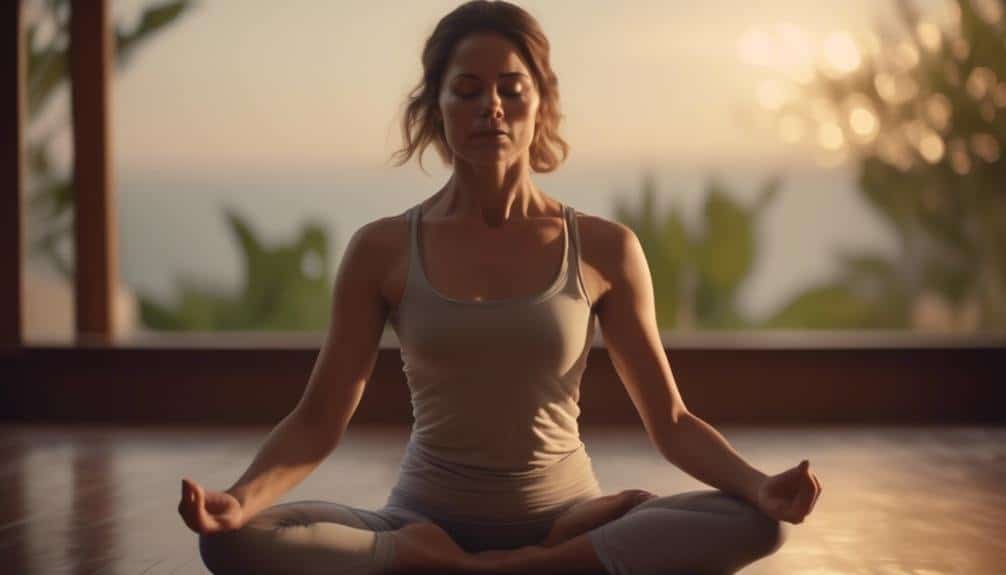Yoga for Mental Health: Finding Inner Peace
Imagine feeling overwhelmed by stress and anxiety daily, unable to find a moment of respite from the relentless demands of life. Now, picture a practice that could potentially offer a path to inner peace and emotional balance.
Yoga has been increasingly recognized as a powerful tool for improving mental health, offering a holistic approach to addressing the complexities of the mind. But how exactly does it achieve this, and what specific techniques can be employed to find solace in the midst of life's chaos?
The answer lies in understanding the profound impact of yoga on mental well-being and the practical strategies it offers for finding inner peace.
Key Takeaways
- Yoga is an effective tool for reducing stress, anxiety, and depression.
- Yoga incorporates relaxation techniques, mindfulness, breathing exercises, and physical postures to promote a sense of calm and mental clarity.
- Regular yoga practice can lower cortisol levels, the hormone associated with stress, and trigger the body's relaxation response.
- Mindfulness and breathwork in yoga enhance mental well-being, improve self-awareness, and provide valuable tools for managing depression symptoms.
Understanding Yoga's Impact on Mental Health
If you're seeking a holistic approach to improving your mental health, understanding the impact of yoga can provide valuable insights into its potential benefits. Exploring yoga's impact on mental health can reveal its profound effects on various aspects of well-being.
Yoga has been shown to reduce stress, anxiety, and depression by promoting relaxation and mindfulness. The practice of yoga involves focused breathing, meditation, and physical postures, all of which contribute to a sense of calm and mental clarity.
In addition to reducing negative emotions, yoga can also enhance positive feelings and improve overall mood. The combination of physical movement and breath control in yoga can stimulate the release of endorphins, the body's natural feel-good chemicals. This can lead to a greater sense of happiness and well-being. Furthermore, the emphasis on self-awareness and self-acceptance in yoga can foster a more positive self-image and improve self-esteem.
Understanding yoga's impact on mental health involves recognizing its ability to cultivate a sense of inner peace and emotional balance. By exploring yoga's benefits, individuals can gain valuable tools for managing their mental and emotional well-being. Whether through a regular practice at home or in a class setting, yoga offers a holistic approach to improving mental health.
The Science Behind Yoga and Stress Reduction
You're probably wondering how yoga actually helps reduce stress.
Well, it turns out that practicing yoga has been linked to lower cortisol levels, the hormone associated with stress.
Additionally, engaging in yoga can trigger the body's relaxation response, promoting a sense of calm and well-being.
Yoga and Cortisol Levels
Understanding the intricate relationship between yoga and cortisol levels offers valuable insight into the science behind how yoga can effectively reduce stress. The impact of yoga on cortisol regulation is profound, influencing stress management through yoga.
The mind-body connection in yoga plays a pivotal role in promoting hormone balance, including cortisol. By engaging in yoga practices, individuals can experience a reduction in cortisol levels, leading to a calmer and more balanced state of mind.
This holistic approach to stress reduction through yoga not only addresses the physical aspects of stress but also targets the hormonal response to stress, providing a comprehensive solution for managing and alleviating stress.
- Yoga and cortisol regulation
- Stress management through yoga
- Mind-body connection in yoga
- Yoga for hormone balance
Yoga and Relaxation Response
The connection between yoga and cortisol regulation demonstrates the scientific basis for the profound impact of yoga on stress reduction, particularly in relation to the relaxation response and its effects on the body's stress mechanisms. When practicing yoga, you engage in relaxation techniques that activate the body's natural relaxation response. This response is associated with reduced levels of cortisol, the stress hormone, leading to a calmer state of mind. Mindfulness meditation, a key component of yoga, further enhances this effect by promoting a sense of present-moment awareness and tranquility. By incorporating these elements into your yoga practice, you actively engage the body's relaxation response, which can help alleviate stress and promote mental well-being.
| Relaxation Techniques | Effects |
|---|---|
| Deep Breathing | Calms the nervous system |
| Progressive Muscle Relaxation | Releases muscle tension |
| Mindfulness Meditation | Promotes present-moment awareness |
| Guided Imagery | Enhances relaxation and visualization |
Yoga Poses for Anxiety Relief
Feeling overwhelmed by anxiety? Try incorporating these yoga poses into your daily routine for relief.
Here are some yoga poses that can help alleviate anxiety and promote a sense of calm:
- Child's Pose: This gentle resting pose helps to release tension in the back, shoulders, and chest, while also promoting deep breathing and relaxation.
- Standing Forward Bend: This pose allows for a gentle stretch of the entire backside of the body, which can help relieve tension and calm the mind.
- Legs-Up-the-Wall Pose: By inverting the body and allowing the legs to rest against a wall, this pose can help calm the nervous system and reduce stress and anxiety.
- Corpse Pose (Savasana): This final relaxation pose is a powerful way to induce a state of deep relaxation, allowing for the release of tension and stress from the body and mind.
Incorporating these yoga poses into your daily routine can provide relief from anxiety and promote a sense of inner peace. Remember to focus on breath control and allow the practice to be a source of stress relief.
Harnessing the Power of Breathwork in Yoga
As you explore the power of breathwork in yoga, you'll find that deepening your breath awareness can be a transformative practice.
By calming the nervous system, intentional breathing can help you navigate moments of stress and anxiety with greater ease.
As you incorporate these techniques into your yoga practice, you may experience enhanced mental clarity and a deeper sense of inner peace.
Deepening Breath Awareness
To deepen breath awareness in yoga, focus on the sensation of your breath moving in and out of your body, allowing yourself to fully engage with the power of breathwork. This practice can help you achieve a deeper state of relaxation and mindfulness.
Here are some techniques to enhance your breath awareness:
- Box Breathing: Inhale for a count of 4, hold for 4, exhale for 4, and hold for 4.
- Alternate Nostril Breathing: Close one nostril while inhaling, then switch and exhale through the other nostril.
- Deep Belly Breathing: Focus on breathing deeply into your belly, allowing it to rise and fall with each breath.
- Breath Counting: Inhale and mentally count '1,' then exhale and count '2,' continuing up to '10.'
Calming the Nervous System
Harnessing the power of breathwork in yoga can be a transformative practice, particularly when it comes to calming the nervous system and promoting mental well-being.
Nervous system regulation is crucial for managing stress and anxiety, and yoga offers effective relaxation techniques to achieve this. Deep, intentional breathing activates the body's relaxation response, signaling the nervous system to calm down. This triggers a decrease in heart rate, blood pressure, and muscle tension, promoting a sense of tranquility and mental clarity.
By consciously engaging in yoga's breathwork, you can cultivate a heightened awareness of the mind-body connection, allowing you to respond to stressors with greater ease and composure.
Embracing yoga for calming the nervous system not only enhances your mental health but also empowers you to navigate life's challenges with resilience and inner peace.
Enhancing Mental Clarity
Embrace the transformative potential of breathwork in yoga to enhance your mental clarity and foster a deeper mind-body connection. By incorporating specific meditation techniques into your yoga practice, you can sharpen your mental focus and improve your overall clarity.
Here are some key ways in which breathwork can enhance your mental clarity:
- Deep breathing exercises can calm the mind and reduce mental chatter.
- Controlled breathing techniques help release tension and promote mental relaxation.
- Breathing practices can improve oxygen flow to the brain, enhancing cognitive function.
- Focused breathing during yoga can bring awareness to the present moment, improving mental clarity.
Through intentional breathwork, you can harness the power of your breath to enhance mental clarity and cultivate a clear and focused mind during your yoga practice.
Cultivating Mindfulness Through Yoga Practice
By incorporating mindfulness into your yoga practice, you can enhance your mental well-being and cultivate a deeper sense of self-awareness. Mindfulness in yoga involves being fully present in the moment, observing your thoughts and sensations without judgment. This practice can significantly improve your focus and increase self-awareness, leading to a greater understanding of your emotions and behaviors.
| Benefits of Cultivating Mindfulness Through Yoga |
|---|
| 1. Improved Focus |
| 2. Increased Self-Awareness |
| 3. Enhanced Emotional Regulation |
Yoga for Depression: A Holistic Approach
To effectively address depression, incorporating yoga as a holistic approach can provide valuable tools for managing symptoms and promoting overall well-being. When dealing with depression, it's important to consider holistic methods that address both the mind and body. Yoga offers a unique approach to mental wellness, providing a range of techniques that can be beneficial for individuals struggling with depression.
- Mindfulness Practices: Engaging in yoga encourages mindfulness, allowing you to become more aware of your thoughts and emotions, which can help in managing depressive symptoms.
- Stress Reduction: Yoga incorporates breathing exercises and gentle movements that can help reduce stress and anxiety, common components of depression.
- Physical Well-being: The physical aspect of yoga can contribute to an overall improvement in physical health, which in turn can positively impact mental well-being.
- Community Support: Participating in yoga classes can provide a sense of community and support, which is essential for those dealing with depression.
Exploring the Connection Between Yoga and Emotional Resilience
When it comes to emotional resilience, yoga offers a powerful tool for finding balance and strength. Through the practice of yoga, you can learn to cultivate emotional resilience, allowing you to navigate life's challenges with greater ease.
The connection between yoga and emotional resilience is a fascinating area to explore, offering valuable insights into how this ancient practice can support your mental well-being.
Yoga and Resilience
Embracing a regular yoga practice can significantly enhance your emotional resilience, providing you with the tools to navigate life's challenges with greater ease and adaptability.
Yoga helps you build strength, not just in the physical sense, but also in mental fortitude. It fosters a sense of inner strength and stability that allows you to bounce back from adversity.
Through mindfulness and breathwork, yoga equips you with the ability to stay calm and centered amidst turbulent times. It teaches you to cultivate a positive outlook, enhancing your capacity to find silver linings in difficult situations.
Moreover, by promoting self-awareness and acceptance, yoga empowers you to develop a more resilient mindset, enabling you to face setbacks with grace and determination.
Emotional Balance Through Yoga
By practicing yoga, individuals can cultivate emotional balance, fostering a deeper connection between their mental resilience and inner stability.
Yoga offers a range of meditation techniques that are specifically designed to promote emotional stability. Through mindfulness and breath-centered practices, yoga enables individuals to develop a heightened awareness of their emotions and the ability to respond to them in a more balanced and constructive manner.
This process can help in regulating emotions, reducing stress, and enhancing overall emotional well-being. The practice of yoga encourages individuals to observe their emotions without judgment, allowing them to acknowledge and accept their feelings while also learning to let go of negative emotional patterns.
Integrating Yoga Into Your Daily Routine
To incorporate yoga into your daily routine, start by identifying a consistent time and space for your practice that aligns with your schedule and lifestyle. This will help make yoga a regular part of your day, allowing you to reap its mental health benefits.
Here are some pointers to help you seamlessly integrate yoga into your daily life:
- Set a Routine: Establish a specific time each day for your yoga practice. Whether it's in the morning to energize your day or in the evening to wind down, consistency is key.
- Designate a Space: Create a dedicated area for your practice, even if it's just a corner of a room. Having a defined space can help you mentally transition into your practice.
- Start Small: If time is a concern, begin with short yoga routines. Even 10-15 minutes can make a difference in your mental well-being.
- Mind-Body Connection: Use your practice as an opportunity to connect with your body and breath, fostering mindfulness and inner peace.
Creating a Calming Yoga Space at Home
Creating a calming yoga space at home begins with finding a tranquil area where you can relax and focus on your practice without distractions. To create a serene atmosphere, consider these yoga space essentials:
| Yoga Space Essentials | Description | Purpose |
|---|---|---|
| Natural Light | Position your mat near a window to let in natural light. | Enhances mood and energy levels. |
| Comfortable Mat | Choose a mat that provides enough cushioning and support. | Reduces discomfort and injury risk. |
| Personal Touch | Add personal items like candles, plants, or meaningful artwork. | Enhances relaxation and connection. |
Finding tranquility is essential for your yoga practice, so make the space your own. Consider incorporating elements that resonate with you and bring you joy. Your personalized practice area should be a reflection of your inner self and should evoke feelings of peace and serenity as soon as you step into it. By curating a space that aligns with your preferences, you can enhance the overall experience of your yoga practice and promote a sense of inner peace.
Embracing Yoga as a Path to Inner Peace
Embracing yoga as a path to inner peace starts with cultivating mindfulness and self-awareness through regular practice and reflection. It's about more than just physical postures; it's a journey towards inner harmony and balance.
Here's how you can embrace yoga as a path to inner peace:
- Mind Body Connection: Yoga helps you develop a deeper connection between your mind and body. Through breath work and mindful movement, you become more attuned to the present moment, fostering a sense of calm and grounding.
- Self-Reflection: Regular practice encourages introspection, allowing you to observe your thoughts and emotions without judgment. This self-awareness can lead to a greater understanding of yourself and your triggers, promoting emotional stability and resilience.
- Stress Reduction: Yoga provides a sanctuary to release tension and stress. By learning to let go of physical and mental strain on the mat, you can carry this skill into your daily life, managing stress more effectively.
- Emotional Healing: Through yoga, you can address emotional wounds and cultivate a sense of compassion towards yourself. This nurturing environment can lead to profound emotional healing and growth.
Conclusion
Congratulations, you've unlocked the secret to inner peace through yoga! Now, go forth and conquer your stress with downward dog and warrior pose.
Remember, the power of breathwork and mindfulness is in your hands (and feet). Embrace the calming yoga space you've created at home and let the emotional resilience flow through you.
Namaste, and may your journey to inner peace be filled with balance, flexibility, and a touch of humor.







